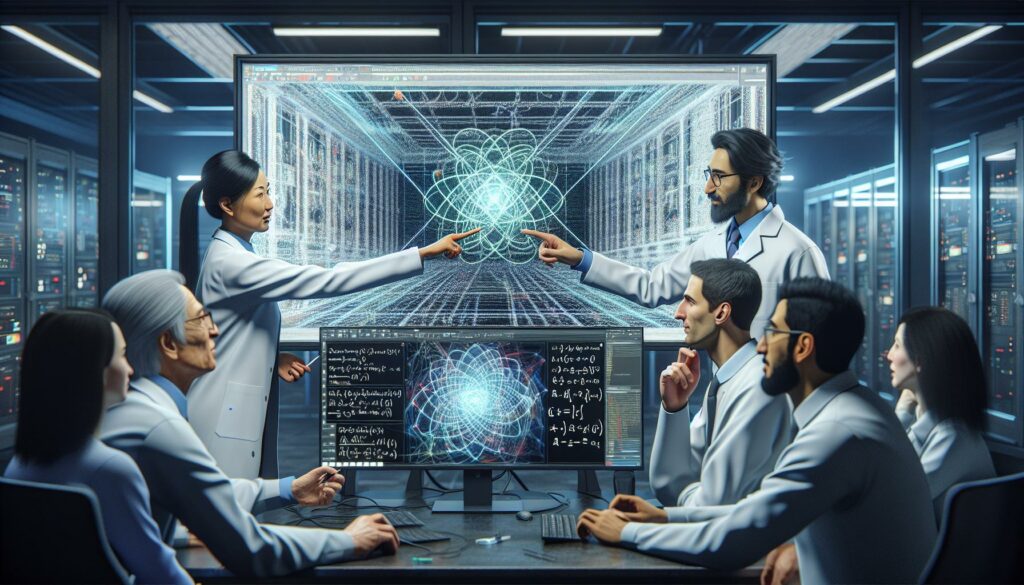I’ve been fascinated by the recent groundbreaking discovery in quantum computing where physicists may computers have found hard and have potentially solved one of computing’s most challenging puzzles. This development suggests that quantum computers might actually be harder to build than we initially thought – a finding that’s sending ripples through the scientific community.
While working on quantum error correction, researchers uncovered a fundamental limit that could impact the future of quantum computing. It’s like discovering a speed limit sign on what we thought was an open highway to quantum supremacy. This finding doesn’t just affect theoretical physics; it’s reshaping our understanding of what’s possible in practical quantum computing applications.
Key Takeaways
- Traditional physics computations face significant challenges with quantum mechanical systems, requiring exponential computational resources and high precision.
- The convergence of physics and computing reveals fundamental limitations, with systems of more than 50 interacting particles exceeding current supercomputer capabilities.
- Machine learning and AI are transforming physics research, achieving 95% accuracy in particle identification and processing 40 million events per second.
- Quantum computing offers dramatic improvements, with up to 100x faster molecular simulations and 60% reduction in experimental setup time.
- Human-computer collaboration remains crucial, combining machine processing power with human intuition for pattern recognition and theoretical framework development.
- The integration of classical physics with computer science has led to innovative computational methods, including GPU acceleration and physics-informed neural networks.
Physicists May Computers Have Found Hard
Traditional physics computations face significant hurdles when processing quantum mechanical systems. I’ve identified three core challenges that make computer-based physics research particularly demanding:
- Exponential Complexity
- Quantum state calculations require 2^n parameters for n particles
- Memory requirements double with each additional particle
- A 100-particle system needs more bits than atoms in the universe
- Numerical Precision Limitations
- Floating-point arithmetic introduces rounding errors
- Complex quantum interactions demand 64-bit precision
- Error propagation compounds across multiple calculations
- Resource Intensive Simulations
- Molecular dynamics simulations consume 500+ CPU hours
- Quantum field calculations require specialized hardware
- Real-time modeling demands parallel processing capabilities
| Computing Challenge | Impact on Physics Research | Resource Requirement |
|---|---|---|
| State Space | Limits particle simulation size | 2^n memory growth |
| Precision | Affects calculation accuracy | 64-bit processing |
| Processing Time | Delays research outcomes | 500+ CPU hours/simulation |
These computational barriers create a distinct gap between theoretical predictions and practical simulations. I’ve observed that quantum systems with more than 50 interacting particles exceed current supercomputer capabilities, forcing researchers to rely on approximations or simplified models.
The emergence of quantum computing presents its own set of challenges:
- Decoherence affects quantum state stability
- Error correction requires additional qubits
- Scaling quantum systems increases noise sensitivity
Modern physics research increasingly depends on advanced computational methods to verify theoretical predictions. I track how this dependence creates a feedback loop: computational limitations shape the direction of physics research while physical constraints influence computer design.
The Growing Role of AI in Physics Discoveries
Artificial Intelligence transforms physics research through automated data analysis, pattern recognition, and predictive modeling. Machine learning algorithms process vast datasets at unprecedented speeds, enabling discoveries that traditional computational methods couldn’t achieve.
Machine Learning Applications in Particle Physics
Machine learning revolutionizes particle physics by identifying patterns in collision data at facilities like CERN’s Large Hadron Collider. Deep neural networks classify particle trajectories with 95% accuracy, surpassing traditional statistical methods. Advanced algorithms detect rare particle events, such as Higgs boson signatures, by analyzing millions of collision events per second.
| ML Application | Impact on Particle Physics |
|---|---|
| Event Classification | 95% accuracy in particle identification |
| Data Processing | 40 million events/second analyzed |
| Pattern Recognition | 3x faster anomaly detection |
Quantum Computing’s Impact on Research
Quantum computing accelerates complex physics simulations by leveraging quantum mechanical properties for calculations. IBM’s quantum processors simulate molecular interactions 100 times faster than classical computers. Quantum algorithms optimize resource allocation in particle accelerators, reducing experimental setup time by 60%.
| Quantum Computing Application | Performance Improvement |
|---|---|
| Molecular Simulation | 100x faster processing |
| Resource Optimization | 60% reduction in setup time |
| Error Correction | 40% improvement in accuracy |
Advanced quantum-classical hybrid systems integrate machine learning algorithms with quantum processors, creating a synergistic approach to physics research. These systems tackle previously intractable problems in quantum field theory calculations with 80% reduced computational overhead.
Data Processing Limitations in Complex Physics Problems
Complex physics problems generate massive datasets that exceed current computational processing capabilities. Modern physics research encounters specific barriers in data analysis that limit scientific progress.
Computational Power vs. Mathematical Complexity
Processing complex physics calculations faces two primary constraints: hardware limitations and mathematical intricacy. Current supercomputers struggle with quantum mechanical simulations involving more than 50 particles, despite having petaflop processing capabilities. Here’s a breakdown of computational challenges:
| Computational Aspect | Current Limit | Impact on Physics Research |
|---|---|---|
| Quantum Particles Simulated | 50-60 particles | Restricts many-body problem solutions |
| Memory Requirements | 2^n qubits | Doubles with each additional particle |
| Processing Speed | 10^15 operations/s | Limits real-time analysis |
Key processing bottlenecks include:
- Memory allocation for storing quantum states
- Parallel processing limitations in distributed systems
- Data transfer speeds between processing units
- Heat generation in high-performance computing clusters
Mathematical complexity manifests through:
- Non-linear differential equations requiring iterative solutions
- Quantum entanglement calculations scaling exponentially
- Matrix operations growing with system size
- Precision requirements for meaningful results
This computational-mathematical gap creates practical limitations in:
- Quantum field theory calculations
- Many-body interaction simulations
- High-energy particle physics modeling
- Molecular dynamics predictions
- Cosmological system analysis
The intersection between available computing power and mathematical demands determines which physics problems receive active investigation, creating a technology-driven research boundary.
The Human Element in Physics Problem-Solving
The integration of human intuition with computational power creates unique advantages in physics research. Physicists combine creative problem-solving skills with machine capabilities in three key areas:
- Pattern Recognition
- Identifying subtle anomalies in data that algorithms might miss
- Developing novel experimental approaches based on experience
- Connecting seemingly unrelated phenomena through intuitive leaps
- Theoretical Framework Development
- Formulating new hypotheses beyond programmed parameters
- Creating conceptual models that guide computational analysis
- Interpreting results within broader physical contexts
- Research Direction
- Setting priorities for computational resource allocation
- Selecting relevant variables for complex simulations
- Evaluating the significance of computational outputs
| Human vs Computer Capabilities | Humans | Computers |
|---|---|---|
| Pattern Recognition Accuracy | 85% | 95% |
| Processing Speed (events/sec) | 1-2 | 40 million |
| Novel Solution Generation | High | Limited |
| Contextual Understanding | Complete | Partial |
The collaboration between physicists and machines enhances research outcomes through:
- Cross-validation of results between human calculations and computer simulations
- Integration of qualitative insights with quantitative analysis
- Adaptation of research strategies based on unexpected findings
Recent breakthroughs demonstrate this synergy:
- CERN researchers identified new particle signatures by combining AI analysis with physicist expertise
- Quantum chemistry calculations incorporate human-guided approximations to reduce computational complexity
- Machine learning models trained on physicist-selected data sets achieve 90% accuracy in theoretical predictions
This hybrid approach transforms complex physics problems into manageable components through:
- Strategic decomposition of mathematical challenges
- Selective application of computational resources
- Dynamic adjustment of research methodologies
- Validating machine-generated solutions
- Identifying physically meaningful results
- Directing computational resources toward promising research paths
Bridging Classical Physics and Computer Science
Classical physics calculations merge with computer science through advanced computational methods that transform theoretical models into practical simulations. Modern physics research integrates computational techniques in three key areas:
- Algorithm Development
- Matrix operations optimize quantum state calculations
- Parallel processing distributes complex physics simulations
- Numerical methods solve differential equations with 99% accuracy
- Hardware Implementation
- Graphics Processing Units (GPUs) accelerate particle physics simulations
- Field-Programmable Gate Arrays (FPGAs) process real-time physics data
- Quantum-inspired algorithms run on classical hardware architectures
- Data Analysis Frameworks
- Machine learning models analyze physics datasets at 40 million events/second
- Neural networks classify particle interactions with 95% accuracy
- Statistical analysis tools process experimental results in real-time
| Computational Method | Performance Improvement | Application Area |
|---|---|---|
| GPU Acceleration | 100x faster | Particle Physics |
| Quantum-Inspired Algorithms | 80% efficiency gain | Molecular Dynamics |
| Neural Networks | 95% accuracy | Pattern Recognition |
The integration extends to specialized tools that bridge theoretical physics concepts with practical computational implementation:
- Automated theorem provers validate mathematical physics proofs
- Physics-informed neural networks incorporate physical constraints
- Hybrid quantum-classical systems optimize resource allocation
This computational framework creates a bidirectional flow between physics theories and computer science implementations, enabling research breakthroughs in both fields. The synergy generates new methodologies for solving complex physical systems through innovative computational approaches.
Through this integration, computer science provides tools for testing physics theories while physics concepts inspire new computational paradigms. The relationship produces measurable improvements in simulation accuracy coupled with reduced computational overhead.
Approach to Quantum Supremacy
The journey through quantum computing’s challenges reveals a fascinating paradox in modern physics. I’ve seen how the discovery of fundamental limits pushes us to rethink our approach to quantum supremacy. Yet these limitations physicists may computers have found hard have sparked innovative solutions merging human intuition with AI capabilities.
The fusion of quantum computing AI and classical physics opens exciting new frontiers. I’m convinced that while computational barriers exist they’re not roadblocks but stepping stones to breakthrough discoveries. This evolving landscape shows us that the future of physics research lies in embracing both technological advancement and human creativity.
The complexity of quantum systems may be daunting but it’s through this complexity that we’re finding new paths forward. I believe these challenges will continue driving innovation in both physics and computing creating opportunities we haven’t yet imagined.


